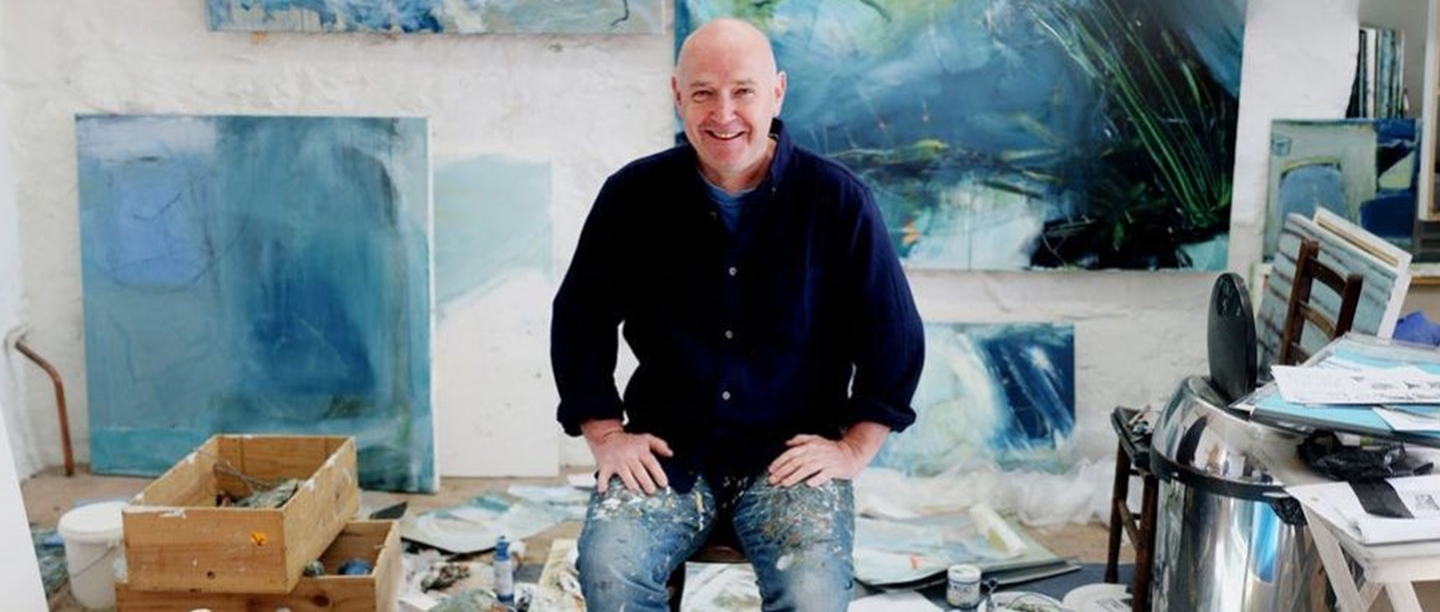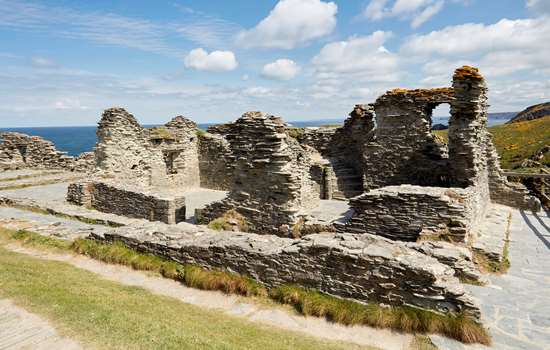
The cover of this year’s Members’ and visitors’ handbook is a little different. It’s a specially commissioned piece by David Mankin, a Cornwall-based artist who paints abstract landscapes. Called Passage, the painting is the artist’s response to the iconic Tintagel Castle in Cornwall.
We caught up with David to discuss his art, his inspiration, and what it means to have his work on the cover of the handbook.
Have you always been an artist?
I’ve always painted from an early age, but was waylaid by a career in commercial art for many years. Around seven years ago I had an opportunity to make work in the famous Porthmeor Studios in St Ives, which reignited my desire to be a painter. It allowed me to re-engage with painting, and some of the work I made during that time sold quite well. It was a catalyst to change my career and it has developed from there. Now my work is widely exhibited and collected.
What drew you to Cornwall?
I visited Cornwall many times over the years. My parents brought me to Cornwall when I was very young and I came back with university friends in the late ’70s when I was a teenager. We brought our eldest son to Mousehole when he was one, in the mid ’90s, and that was when we began to make plans to live here.
I fell in love with the art of Cornwall, especially the abstract art of the ’50s and ’60s. There was an explosion of expressionistic abstract painting at that time, which I was particularly drawn to, with artists like Peter Lanyon and Roger Hilton – but especially Lanyon. His paintings are rooted in the Cornish landscape.
We eventually moved to Perranuthnoe in 2002, when our children were 6 and 10. We saw a house we loved, finally realising our dream!
Why has Cornwall inspired so many artists?
Cornwall has a kind of magnetic draw. It’s a wild, rugged landscape, but it’s also subtle and beautiful at the same time. It’s very contrasting.
You can travel just a few miles from Penzance over to St Just or St Ives, and the landscape shifts dramatically from the coast to the moorland and back to the coast. There are so many different perspectives in such a small area. That’s very exciting from an artists’ point of view, because you’re continually getting that altered perspective on the landscape.
When you add the Cornish weather into the mix you get drama and movement and energy that you don’t get in other places. An important thing for me is that sense of being on the edge – a confrontation of the land and the sea. There is always something fresh and new happening in terms of the way the landscape changes.
How would you describe your work?
I’d describe it as abstract landscape painting, or expressionistic landscape painting. As an artist I’m responding to the Cornish landscape. I’m attempting to communicate and express my experiences in that landscape and a sensual response to it.
It’s an embodiment of my experience. It’s a convergence of thoughts and feelings – remembering in paint.
There’s a wonderful extract from a letter by John Wells:
“So all around the morning air and the sea’s blue light, with points of diamond, and the gorse incandescent beyond the trees, countless rocks ragged or round in every colour, birds resting or flying, and a sense of a multitude of creatures living out their minute lives….
All this is part of one’s life and I want desperately to express it; not just what I see, but what I feel about it… but how can one paint the warmth of the sun, the sound of the sea, the journey of a beetle across a rock, or thoughts of one’s own whence and whither?
That’s one argument for abstraction. One absorbs all these feelings and ideas: if one is lucky they undergo an alchemistic transformation into gold that is creative work.”
John Wells (1907 -2000), in a letter to Sven Berlin, 1950. From Painting the Warmth of the Sun, St Ives artists 1939-1975, Tom Cross, Halsgrove, 1997.
I wish I’d written that – it sums it up. Because how do you paint the warmth of the sun, and those kind of feelings when you’re out in the landscape? The waves are crashing, gulls flying around, wind, rain, there’s so much going on, sensory experiences, how do you express that? That’s what I’m searching for, because the Cornish landscape is my source, my inspiration.
How do you go about creating your work?
My process starts by being in the landscape. I go walking or cycling. That initial visual stimulation; the textures, the colours, the shapes, and the movement. It all collides together, creating a wealth of spatial relationships. That’s my source material. When I’m walking things are just constantly catching my eye, and I’ll take a picture or make a sketch.
When I’m back in the studio it becomes almost an explosion of mark making, free association and gestural paintwork. It’s really about engaging with the materials and exploring possibilities in paint, and with the surfaces I work on.
Then it becomes important to try and edit the painting, and I start layering; painting over areas, scratching into it and unearthing marks. It’s like the process of the elements on the landscape – the weather acting on the coast. During this process things develop and connections are made. I aim to try to balance the composition in terms of the line and the texture and the scale and the colour.
Paintings can take weeks or months or sometimes years. I might put them to one side and go back to them, maybe add a new element or sometimes It’s an incremental process. I’m searching for something in my own mind that feels right – it’s a kind of mood, a feeling of rightness that I want from the painting. When I get to that point, it comes close to being finished!
And what was it like creating Passage, your piece for the handbook?
When I was approached about the project, it really sparked my interest in going back to Tintagel. We took our children there a few years ago, but the prospect of being there with my artist’s eyes was a really interesting opportunity, and wow, what a spot it is! It’s an incredible site.
As you walk down from the village of Tintagel, there is a tantalising sense that something lies ahead. You can’t really see much, but as you pass through the gatehouse and the courtyard, it opens up to a dramatic vista, a natural crossing point. You have a breathtaking view of the main island with the sweeping Cornish sea behind. You feel as if you have arrived on the edge of something – it really is very special.
Your sight lines are pulled in every direction when you get to that point of Tintagel. There’s the haven, the island, the sea, the chasm where the land has fallen away and soaring dark cliffs dropping into the sea – there is so much to take in.
When I visited, the sun was shining and the colours were mesmerising. The sea was an intense vibrant jade blue, and from a distance the grass covering the surrounding headlands had a lime green velvety quality. Orange lichen edged the castle walls, and the jagged stones of the remains created intricate geometric shapes. There were so many things that were sparking my senses.
And did you get a sense of the history of the place as well as of the landscape?
Very much. With the ruins and the weathering and the jaggedness of the rocks, there’s a textural, architectural quality there that’s very pleasing. You can just imagine why a castle was built in such a commanding, defensive position. When you are there you can see and feel Tintagel’s layered history, not only of man’s impact over the centuries, but also how the fury of the Cornish weather and the relentless pounding of the sea has shaped the spectacular headland.
How does it feel to know that Passage will be delivered to hundreds of thousands of English Heritage Members?
It’s a great honour to have my painting on the handbook and to be representing such an iconic Cornish landmark. Although there were some ups and downs through the painting process I’m thrilled with the final result. It makes a striking front cover and I hope members will be intrigued to find out more. I do hope that people will enjoy looking at it as much as I enjoyed making it!
What do you hope Members get from the piece?
‘I’m sure there’ll be lots of different views, but I hope they will get a feeling of that sensory experience of being at Tintagel. I guess some people may need to give it a bit of time, because it’s not immediately obvious – it’s an abstract painting after all! But I hope they embrace it and enjoy it.
Watch the video
Join English Heritage
English Heritage Members get a free copy of the handbook delivered each year – along with free entry to over 400 historic sites across the country. Membership also helps to care for these places, keeping the story of England alive for future generations. Find out more and join today.





